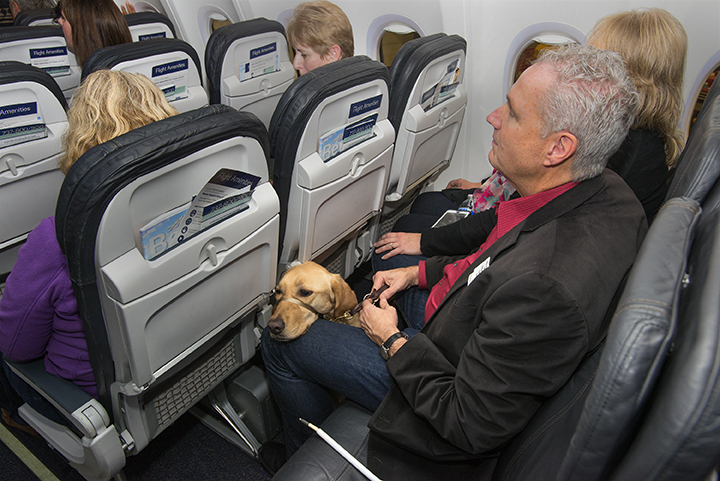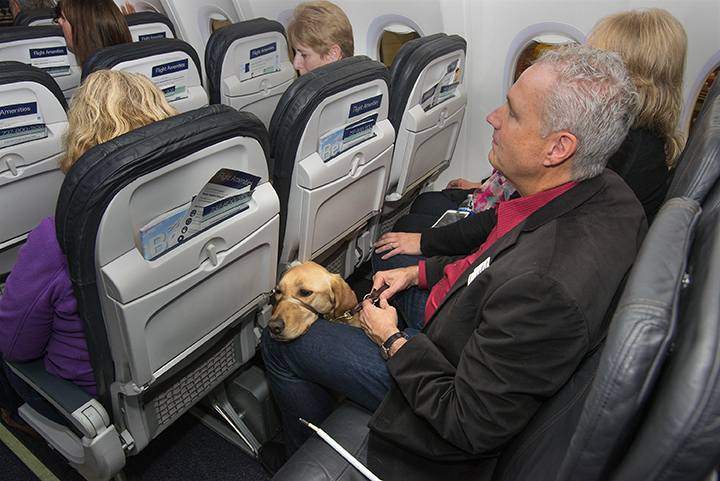Flying Blind: Alaska event allows blind and low vision customers to familiarize themselves with flying
Share

Many travelers take the process of flying for granted. Making a reservation, going through security, finding the correct gate, boarding a flight, and finally arriving at their destination may be a routine process, but for those who are blind or have low vision, flying is a much different experience.
“When you’re visually impaired, flying is like going from a seat in one building to a seat in another building that happens to go 500 miles per hour,” said Jake Koch, outreach alumni representative for Guide Dogs for the Blind, an organization that prepares guide dogs to serve those who are blind or have low vision.
Alaska Airlines, along with Guide Dogs for the Blind, Vision Loss Connections, and Washington State Department of Services for Blind, partnered last week to bring a little more ease and familiarity into that experience. They invited a group of people, service dogs, and dog trainers to board a Boeing 737 aircraft at the Alaska Airlines hangar in Sea-Tac for a mock flight demonstration, where they were given verbal information about the flying process and allowed to touch portions of the aircraft. The event was founded by Alaska flight attendant Shirley Purkey, three years ago at the urging of a friend who teaches braille locally.
Event volunteers including captain Brian Horton and flight attendants Purkey, Patrick Inouye, Carole Scallon, and Desiree Endert led participants through a flight simulation that included boarding and deplaning, a safety briefing, inflight announcements, and snacks. Participants were invited to tour the plane, which for the visually impaired meant touching the landing gear and visiting the flight deck, lavatories and galley. They took participants through the seat layout, showed them the call button and knobs above the seat, and let them tour the lavatory to help prepare them for a “real life” flying experience.
Koch, who is visually impaired, is now flying savvy, but he’ll never forget the first time he flew alone.
Koch, now 27, first flew by himself at age 16, from Lewiston, Idaho to Seattle for a summer camp.
“I remember thinking ‘I’ll be all by myself when the plane lands in a place I’ve never been before’,” he said.
But some advice from Koch’s parents helped him stay strong through the experience.
“They always taught me to be like everyone else and do what everyone else is doing,” he said.
This advice has helped him in all aspects of his life, including flying. He recently returned from a two-week, solo trip to Europe.
Andre Cuestra of Tacoma attended the event with his guide dog Thoreau. Cuestra had not been on an airplane since losing his vision three years ago. A planned flight in December to visit family in West Palm Beach, Florida had him feeling anxious about the whole experience. What was once familiar to him now came with complications.
“I was feeling so overwhelmed,” he said. The thought of managing Thoreau, who will be flying for the first time, and finding his way through the airport into a small enclosed space seemed like the makings of a stressful situation.
During the mock flight, Cuestra sat with flight attendant Carmen Layne, who showed him the ropes. She said the event helped her to understand the needs of passengers who are visually impaired, as well as inform them that she is here to help.
“[During an actual flight] there is not a lot of time to communicate; this helps me to be sensitive,” she said.
“This [experience] gives me the confidence to know everything is going to be ok; I know I can ask any questions of what I need to know without any issues,” said Cuestras.
Tips for easier traveling for individuals who are blind or have low vision
Traveling with a visual impairment can be stressful, but the following tips can help make the experience go a little more smoothly.
1. Communicate
Brian Robey, a member of Alaska’s accessibility advisory board and the company’s liaison to Guide Dogs for the Blind, says Alaska really appreciates customers letting employees know of their specific needs, at every touch point (at check-in, boarding, or inflight) so they have the opportunity to assist.
Communication between airline personnel and those who are visually impaired is key.
“Ask for what you want and need,” Koch said. “If you don’t know, just ask.”
He said there is a public perception that those with visual impairments are clueless about the whole traveling experience. But it’s important not to make assumptions. Comfort with the flying process and needs vary from person to person.
“Some are confident and competent and can get around no problem,” he said. “It’s just important to be aware of what you want and need.”
Flight attendants are trained to make sure they are giving people with disabilities the help they need. Each aircraft is equipped with manuals in Braille and flight attendants escort people around the cabin when needed.
2. Befriend fellow travelers
Fellow travelers are a great resource for those who are visually impaired, because everyone is trying to navigate potentially unfamiliar surroundings.
“[Other travelers] can be just as confused as you,” Koch said. “It helps to be like everyone else and get in there and do what everyone else is doing.”
Koch said he’s had the best conversations with other travelers like that. He said fellow travelers are usually friendly and often very curious, especially about his guide dog, Forli.
3. Be prepared
“When you are traveling, you often feel rushed,” Koch said. “You have no time to think of the best technique to accomplish something.”
Visually impaired travelers can prepare for their trip beginning when they first make their flight reservation. They can ensure they receive a seat where they would be most comfortable, often the bulkhead seat. Contact Reservations at 1-800-ALASKAAIR for special seating accommodations.
Upon the request of visually impaired passenger, airlines like Alaska are able to provide assistance to and from the gate, on and off the aircraft, and between connecting flights. Be sure to inform a Customer Service Agent of your needs when you arrive at the airport.
If a passenger needs assistance from the drop off location at the airport to the gate, it is important to plan for that in advance, said Koch.
By self-identifying to the gate agent, visually impaired passengers can also take advantage of pre-boarding to give themselves time to get themselves situated.
Families with any extra questions or concerns about getting through security can call the TSA Cares hotline at 1-855-787-2227.
Learn about Alaska’s accommodations for individuals with disabilities at alaskaair.com.
